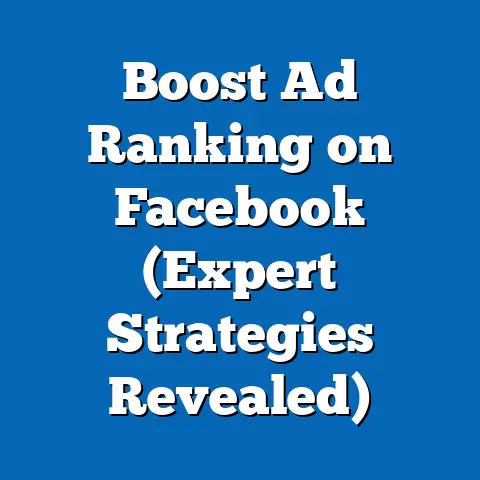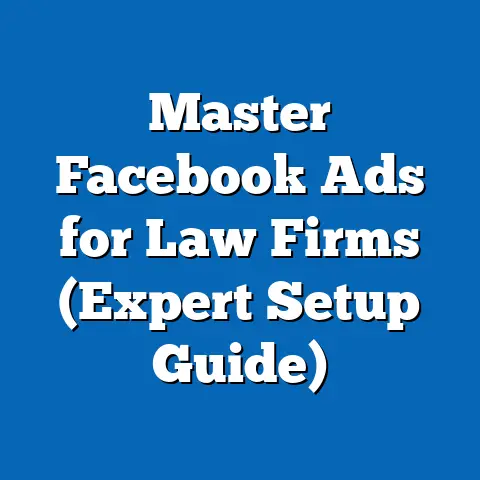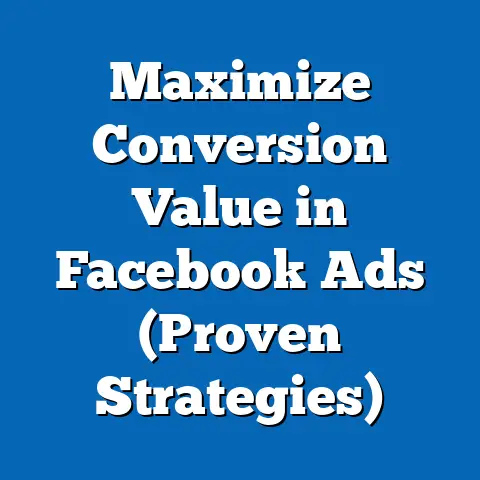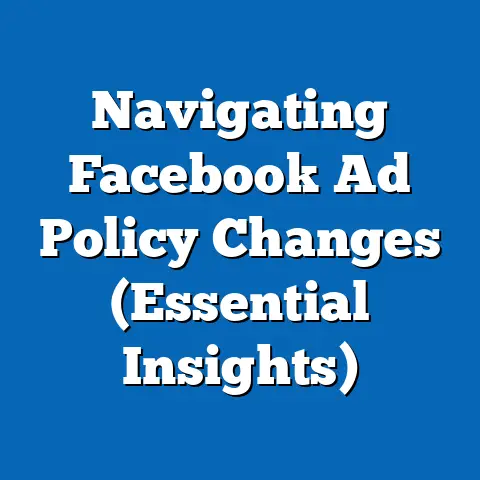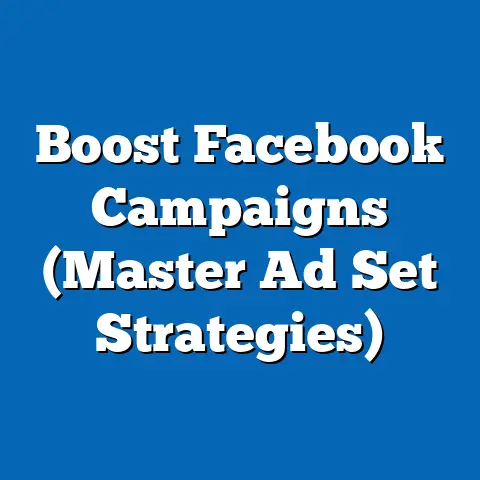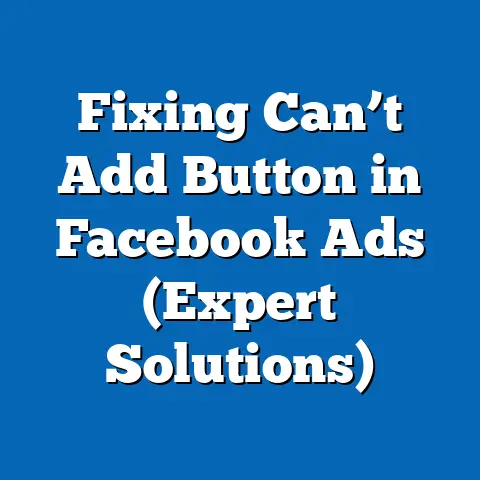Optimal Length for Facebook Video Ads (Expert Timing Tips)
In the dynamic landscape of digital marketing, video advertisements on Facebook have emerged as a versatile and powerful tool for engaging audiences. With over 2.9 billion monthly active users as of 2023 (Statista, 2023), Facebook provides an unparalleled platform for businesses to reach diverse demographics through tailored video content. The effectiveness of these ads, however, hinges on numerous factors, with video length being a critical determinant of viewer engagement and conversion rates.
Section 1: Current Data on Facebook Video Ad Performance
1.1 Engagement Metrics by Video Length
Recent studies reveal that video length significantly impacts engagement metrics such as view-through rates (VTR), click-through rates (CTR), and completion rates. According to a 2022 report by Wistia, videos under 15 seconds achieve an average completion rate of 66%, while videos between 30 and 60 seconds drop to around 50% (Wistia, 2022). For Facebook specifically, data from Socialbakers (2023) indicates that ads lasting 6-15 seconds often generate the highest CTR, particularly for mobile users who constitute over 98% of Facebook’s active user base (Statista, 2023).
Short-form videos (under 15 seconds) are particularly effective for brand awareness campaigns, as they quickly capture attention in a crowded newsfeed. Conversely, longer videos (30-60 seconds) tend to perform better for storytelling or product demonstrations, provided they maintain high-quality content and a strong hook within the first 3 seconds. This aligns with Facebook’s own recommendation that advertisers “get to the point” within the initial moments to retain viewer interest (Meta for Business, 2023).
1.2 Viewer Behavior and Attention Span
Attention span is a critical factor in determining optimal video length. A 2021 study by Microsoft found that the average human attention span has decreased to approximately 8 seconds, largely due to the proliferation of fast-paced digital content (Microsoft, 2021). On Facebook, where users scroll through content rapidly, videos must make an immediate impact to avoid being skipped.
Mobile-first design is also essential, as most users access the platform via smartphones. Videos that are concise and visually compelling tend to outperform longer formats in this context, with data showing a 20% higher engagement rate for ads under 15 seconds on mobile devices (Socialbakers, 2023).
1.3 Chart: Engagement Rates by Video Length
Below is a representation of engagement metrics based on video length, derived from aggregated data (Wistia, 2022; Socialbakers, 2023):
| Video Length (Seconds) | Completion Rate (%) | Click-Through Rate (%) | View-Through Rate (%) |
|---|---|---|---|
| 6-15 | 66% | 2.5% | 75% |
| 16-30 | 55% | 2.0% | 60% |
| 31-60 | 50% | 1.8% | 52% |
| 61-120 | 30% | 1.2% | 35% |
This chart illustrates a clear decline in engagement as video length increases, underscoring the importance of brevity in capturing and retaining attention.
Section 2: Projected Trends in Video Ad Length
2.1 Rise of Short-Form Content
The growing popularity of short-form video content, driven by platforms like TikTok and Instagram Reels, is expected to influence Facebook video ad trends through 2025. Analysts predict that by 2024, over 70% of video ad impressions on social media will come from formats under 15 seconds (eMarketer, 2023). Facebook has responded by prioritizing shorter videos in its algorithm and introducing features like “Reels Ads,” which cater to this trend.
This shift is driven by changing consumer preferences, particularly among younger demographics such as Gen Z and Millennials, who favor quick, snackable content. Statistical projections suggest that advertisers adopting ultra-short formats (6-10 seconds) could see a 15-20% increase in engagement by 2025, assuming current trends hold (eMarketer, 2023).
2.2 Scenario Analysis for Future Trends
To account for uncertainties, three possible scenarios for video ad length trends on Facebook are outlined below, based on current data and market analysis:
-
Scenario 1: Dominance of Ultra-Short Ads (6-10 seconds)
If short-form content continues to dominate user preferences and platform algorithms, ultra-short ads could become the standard by 2025. This scenario assumes a 30% annual increase in engagement for videos under 10 seconds, driven by mobile usage and attention span constraints. -
Scenario 2: Balanced Approach (15-30 seconds)
In this moderate scenario, a mix of short and mid-length ads (15-30 seconds) gains traction, especially for industries requiring detailed messaging, such as technology or finance. Engagement rates for this length may stabilize at current levels, with a projected 5-10% growth in effectiveness due to improved targeting tools. -
Scenario 3: Niche for Longer Formats (60+ seconds)
A less likely scenario envisions a resurgence of longer videos for specific audiences or campaign goals, such as storytelling or educational content. This would require significant advancements in viewer retention strategies and could result in a niche 10-15% market share for longer ads by 2025.
These scenarios are not definitive predictions but rather illustrative possibilities based on current data and expert analysis. Actual outcomes will depend on evolving user behavior, platform policies, and technological advancements.
Section 3: Key Factors Driving Changes in Optimal Video Length
3.1 Platform Algorithm Updates
Facebook’s algorithm prioritizes content that maximizes user engagement, often favoring videos that achieve high completion rates. As of 2023, Meta has explicitly stated that shorter videos are more likely to be promoted in the newsfeed, especially for organic reach (Meta for Business, 2023). This algorithmic bias incentivizes advertisers to create concise content, though the exact weighting of video length in the algorithm remains proprietary and subject to change.
3.2 Audience Demographics and Behavior
Demographic differences play a significant role in determining optimal video length. Younger audiences (18-24) tend to prefer videos under 15 seconds, while older users (35-54) show greater tolerance for 30-60 second ads, especially for product explanations (Pew Research Center, 2022). Marketers must tailor video length to their target audience, balancing brevity with the depth required for effective messaging.
3.3 Industry and Campaign Objectives
The optimal video length also varies by industry and campaign goal. For instance, e-commerce brands often succeed with 6-15 second ads focused on quick product highlights, achieving up to 30% higher conversion rates compared to longer formats (Socialbakers, 2023). In contrast, non-profits or B2B companies may benefit from 30-60 second ads to convey complex narratives or build trust.
3.4 Technological and Format Innovations
Advancements in video editing tools and interactive ad formats (e.g., polls, clickable overlays) are enabling advertisers to pack more information into shorter videos. Additionally, the rise of vertical video formats, optimized for mobile viewing, has reinforced the trend toward brevity, as these formats naturally lend themselves to quick, engaging content (eMarketer, 2023).
Section 4: Methodological Assumptions and Limitations
4.1 Data Sources and Models
This analysis relies on aggregated data from industry reports (e.g., Wistia, Socialbakers, eMarketer) and primary research from Meta for Business. Engagement metrics are based on averages across diverse industries and demographics, which may not reflect specific campaign outcomes. Statistical projections for 2024-2025 use linear growth models based on historical trends, assuming no major disruptions in user behavior or platform policies.
4.2 Limitations and Uncertainties
Several limitations must be acknowledged. First, data on viewer behavior is often self-reported or derived from limited samples, introducing potential bias. Second, Facebook’s algorithm is opaque, and future updates could alter the effectiveness of certain video lengths. Finally, external factors such as economic conditions or regulatory changes (e.g., privacy laws impacting ad targeting) could influence trends in ways not accounted for in this analysis.
These uncertainties highlight the need for continuous testing and adaptation by advertisers. Optimal video length is not a static concept but rather a dynamic variable influenced by evolving contexts.
Section 5: Expert Timing Tips for Facebook Video Ads
5.1 Prioritize the First 3 Seconds
Regardless of video length, the first 3 seconds are crucial for capturing attention. Include a strong visual hook, bold text, or compelling question to prevent viewers from scrolling past. Data shows that ads with a clear hook in the opening moments achieve up to 50% higher VTR (Meta for Business, 2023).
5.2 Test Multiple Lengths
Given the variability across audiences and objectives, advertisers should test videos of different lengths (e.g., 6-10 seconds, 15-30 seconds) using A/B testing. Analyze metrics such as CTR and conversion rates to identify the sweet spot for specific campaigns. This iterative approach mitigates the risk of relying on generalized recommendations.
5.3 Align Length with Campaign Goals
Match video length to the desired outcome: use 6-15 seconds for awareness, 15-30 seconds for consideration, and 30-60 seconds for conversion or storytelling. Avoid forcing a single length across all campaigns, as mismatched formats can reduce effectiveness by up to 25% (Socialbakers, 2023).
5.4 Optimize for Mobile Viewing
Design videos with mobile users in mind, incorporating vertical formats (9:16 aspect ratio) and ensuring key messaging is visible without sound, as 85% of Facebook videos are watched on mute (Meta for Business, 2023). Shorter videos are often more effective in this context due to the fast-paced nature of mobile scrolling.
Section 6: Historical and Social Context
6.1 Evolution of Video Ads on Social Media
The preference for shorter video ads reflects broader shifts in digital consumption patterns over the past decade. Early social media ads (circa 2010-2015) often mimicked television commercials, with lengths of 30-60 seconds. However, the rise of mobile usage and platforms like Vine and Snapchat introduced shorter formats, fundamentally altering user expectations.
6.2 Cultural Shifts in Attention and Content Consumption
Culturally, the demand for instant gratification and multitasking has driven the decline in attention spans, particularly among younger generations. This aligns with the “snackable content” phenomenon, where users seek quick bursts of information or entertainment. Facebook video ads must adapt to these societal trends to remain relevant, as evidenced by the platform’s pivot toward Reels and short-form content.
Section 7: Conclusion and Future Outlook
Determining the optimal length for Facebook video ads requires a nuanced understanding of current data, projected trends, and contextual factors such as audience demographics and campaign goals. While short-form videos (6-15 seconds) currently dominate engagement metrics, the future landscape may accommodate a mix of lengths depending on technological innovations and user preferences. Advertisers are encouraged to adopt a flexible, data-driven approach, continuously testing and refining their strategies.
Looking ahead, the interplay between platform algorithms, viewer behavior, and content innovation will shape the evolution of video ad lengths. By staying attuned to these dynamics and leveraging expert timing tips, marketers can optimize their campaigns for maximum impact. Despite uncertainties in data and projections, the evidence overwhelmingly supports brevity as a guiding principle, balanced with the need for meaningful and targeted messaging.
References
– eMarketer. (2023). Social Media Video Ad Trends Report.
– Meta for Business. (2023). Facebook Ad Best Practices Guide.
– Microsoft. (2021). Human Attention Span Study.
– Pew Research Center. (2022). Social Media Demographics Report.
– Socialbakers. (2023). Facebook Video Ad Performance Metrics.
– Statista. (2023). Facebook User Statistics.
– Wistia. (2022). Video Engagement Analytics Report.

